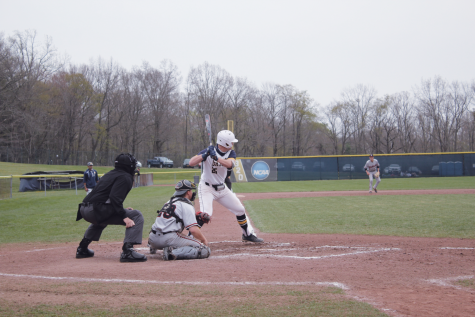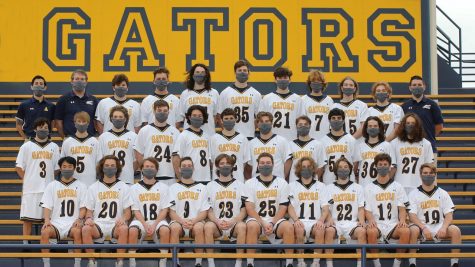Allegheny athletes practice during COVID-19 pandemic
Allegheny men’s baseball team practice for the fall 2020 season during the COVID-19 pandemic
After many months of trouble-shooting and devising strategies to minimize the threats presented by COVID-19, coaches across the nation are hopeful that close-contact collegiate sports can become a reality once again.
Abiding by the daily reminders of the Allegheny College Health Agency, Allegheny’s student athletes are adapting to a “new normal” in regard to practice settings.
Isaiah Lucas, ’22, a pitcher and outfielder for the Gators’ baseball team explains that Allegheny’s athletes are currently doing their best to keep their heads above water, balancing the new preventative measures instilled by their coaches, the ACHA and the NCAA. Further, he admitted to his personal struggles of certain protocol adherences.
“Just when you need a breath of fresh air, you get a mouthful of mask,” Lucas said, referring to his experience during a recent run-in with repetitive sprints.
Even though wearing a face covering at all times may be troublesome in certain situations, Lucas realizes the alternative: no baseball season.
He shared the disappointment that his team and many others faced when their seasons came to an abrupt end last spring and hopes that the preventative measures that the team is currently taking will save their spring 2021 season.
“(The baseball team is) just doing the best we can right now — trying to stay positive, focused and hopeful for a chance to play,” Lucas said. “When the time comes, we’ll be ready.”
The baseball team is not the only group who has made accommodations; many student athletes are accustomed to catching rides to practice with their teammates, sharing sporting equipment and splitting their turf with other teams. Yet in order to begin the resocialization of society and sport, athletes are asked to forgo these once normal actions.
Madelyn Hill, ’22, a member of the women’s soccer team, shared that some players are walking to practice.
“Luckily, my roommates and I are able to ride together,” Hill said. “But I know that some girls have had to make the hike to Robertson (Athletic Complex) because the cars reach capacity quickly.”
Hill explained that roommates are welcome to ride together with little concern, whereas non-roommates are forced to take extra precautions. In the case of the latter, the car is limited to three people: one driver and two passengers in the back seat — of course, sporting their masks.
Women’s soccer devised a plan to limit the number of players in the Wise Center; three pods (eight people per pod) divvy up their allotted gym slots.
Hill explained that one pod completes their lift using the equipment in Wise while the two remaining pods carry out their lift outdoors, in the grassy area beside Crawford Hall.
“Our coach reminds us to bring our heaviest textbooks,” Hill said.
With the intentions of very little to no overlap time, teams are encouraged to stick to their assigned field time, often making it a race against the clock to finish practice before another team takes the field. Gabby Eberle, ’22, a member of the women’s lacrosse team, explained that while the time limits are worthwhile in terms of safety, they can create quite a backup.
“(The lacrosse team) seemed to have pulled the short end of the stick in terms of field slots; Friday practices are late ones,” Eberle said. “Sometimes, we don’t make it back to campus until after ten.”
Besides playing under the Friday night lights, Eberle feels that the lacrosse team has a “good thing going,” considering the circumstances.
“Players are to be six feet apart at all times,” Eberle said. “The rule is that if I extend my arm with my lacrosse stick in hand, I should not come into contact with anyone. It’s like a very large personal bubble.”
Staying six feet apart is a common denominator amongst teams. Chelsea Pietrzycki, ’21, diver and captain for the women’s swim and dive team, shares that practicing at a distance is basically their “only option” for the time being. At this time, the reopening of Mellon Pool is tentative. Pietrzycki has resorted to engaging her team in “dryland,” consisting of cardio and body-weight training, while awaiting their return to the water.
On Friday, Sept. 25, Provost and Dean of the College Ron Cole released an update via email announcing a successful completion of Phase 1 which required coaches to have close supervision of athletes upon the conduction of a training session to ensure the presence of physical distancing.
Varsity and club sports will now move on to Phase 2 of the resocialization plan. Many of the same enforcements will still be in place, in addition to the completion of extra, daily COVID-19 screenings for weightlifting sessions and practices.
The achievement of Phase 1 allows the Gators to progress in their training as some limitations have been lifted, but the future of collegiate sports within the 2020-2021 school year is still uncertain. However, according to Pietryzcki, the Gators are overlooking the precariousness, keeping their hopes high and their minds open to new, innovative ideas to implement into their training.
“It is a learning process,” Pietrzycki said. “While the uncertainty is frustrating, we know this situation will not last forever. We have the future Gators to consider.”









